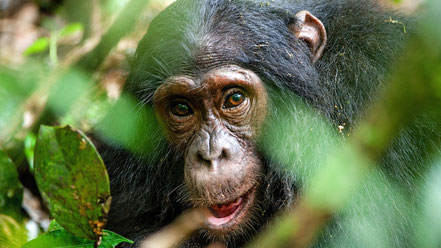where can i go gorilla habituation experience in uganda?

Gorilla Habituation Expedition doesn’t have any actual definition. However, it is simply known as an act of training the wild mountain gorillas to get used to the sight of human beings. Click here to view mountain gorilla trekking safaris.
The gorilla habituation experience involves trackers, researchers, conservationists, and park rangers. When you find gorillas, you are permitted to spend four hours with them. Gorilla habituation takes approximately 2–3 years to be completely done. Click here to see our recommended mountain gorilla trekking tour.
It is a learning process that has become a stable activity, introduced by the Uganda Wildlife Authority on a small scale. Gorilla habituation experience only restricts a maximum of four travelers per day. Those interested in gorilla habituation are advised to book six months prior to their travel date.
Gorilla habituation is only done in Bwindi Impenetrable Forest National Park in the Rushaga sector.
Unlike normal gorilla trekking, which requires travelers to spend an hour interacting with these mountain gorillas, the gorilla habitat experience permits travelers to spend 4 hours in the presence of mountain gorillas. As one spends more time with mountain gorillas, it costs US$1500 per person interested in the gorilla habituation experience, and normal gorilla trekking costs US$800. Click here for gorilla trekking tours.
Gorilla habituation doesn't exist in Rwanda and the Democratic Republic of the Congo; it can only be done in Uganda at Bwindi Impenetrable Forest National Park.
Bwindi impenetrable forest national park protects close to 11 habituated mountain gorilla families that include the Habinyanja gorilla family, the Mubare gorilla family, and the Rushegura family, all in Buhoma sector, in the northern part of Bwindi impenetrable forest national park; the Mishaya gorilla family; the Bweza gorilla family; the Nshonji gorilla family; the Kahungye gorilla family; the Busingye gorilla family, located in the south of the park in Rushaga sector; and the Nkuringo gorilla family.
Oruzogo gorilla family, Kyaguriro gorilla family, and Bitukura gorilla family in the Ruija sector However, only two mountain gorilla families are set up at Rushaga for Gorilla habituation experiences.
What can i do in Bwindi impenetrable forest national park?
Bwindi impenetrable forest national park is situated in southwestern Uganda, in Kanungu district. Bwindi impenetrable forest national park was gazetted in 1991 with the main purpose of protecting the endangered mountain gorillas.
Bwindi Impenetrable Forest National Park accommodates not only the endangered mountain gorillas but also other different wildlife species such as forest elephants, bush pigs, buffaloes, giant forest hogs, antelopes, primate species like l’hoest monkeys and baboons, different bird species, beautiful butterflies, and plant species.
Mountain gorilla trekking is an exceptional tourism activity in Bwindi Impenetrable Forest National Park, where tourists move deep into Uganda’s tropical rainforest while searching for mountain gorillas. Bwindi impenetrable national park habituates about 19 mountain gorilla families, which are located in four different sectors of Bwindi, namely the Buhoma sector in the north, the Rushaga sector in the south, the Nkuringo sector in the south, and the Ruhijja sector in the east.
The mountain gorilla habituation experience is yet another extraordinary and incredible tourism activity in Bwindi Impenetrable Forest National Park, where visitors have the opportunity to spend at least four hours with the gorillas during the habituation process.
Gorilla habituation is a procedural activity where the wild gorillas are trained to get used to human beings’ presence. The gorilla habituation process takes about 2 to 3 years to be done completely, and it involves a team of researchers, travelers, scientists, and park rangers. Gorilla habituation is only done in one sector, called the Rushaga sector, in the southern part of Bwindi Impenetrable National Park.
Bwindi impenetrable national park accommodates more than 360 bird species, which include Albertine Rift endemic species, forest birds, and migratory birds, making Bwindi Forest the birder's paradise. Bwindi forest bird species include African green pigeon, giant kingfisher, African emerald cuckoo, Ruwenzori nightjar, common bulbul, cinnamon chested bee-eater, handsome francolin, blue-headed sunbird, dwarf honeyguide, collared apalis, red-throated Alethe, red-faced woodland warbler, yellow-eyed black flycatcher, archer’s robin chat, strip-breatered tit, Kivu ground thrush, strange weaver, dusky Crimsonwing, and many more.
The nature walk is an incredible tourism activity in Bwindi impenetrable forest national Park, where travelers can explore Bwindi forest on foot with a well-trained, experienced park guide and an armed park ranger to protect everyone from danger.
Batwa cultural experience is an interesting tourism activity in Bwindi impenetrable forest national park that gives you an incredible opportunity to interact with Uganda’s pygmies, the Batwa people, who used to stay in Bwindi forest before it was turned into a national park.
When is the best time to go Gorilla habituation experience?
Bwindi Impenetrable Forest National Park can be best visited in the dry seasons that kick off from June to September every year and from December, February, and early March, which is the short dry season when less rainfall is received.
Uganda’s rainy seasons come with heavy rainfall amounts, which makes the trekking trails slippery and muddy, making it kind of hard to participate in gorilla trekking and nature walks.
The best time to visit Bwindi Impenetrable Forest National Park is during the two dry seasons. The long dry season lasts from June to September, and the short dry season starts from December to March.
During this season, travelers have the best chance to see the clear weather in Uganda. Although it can rain at any time, touring Bwindi Forest National Park can be done throughout the year.
